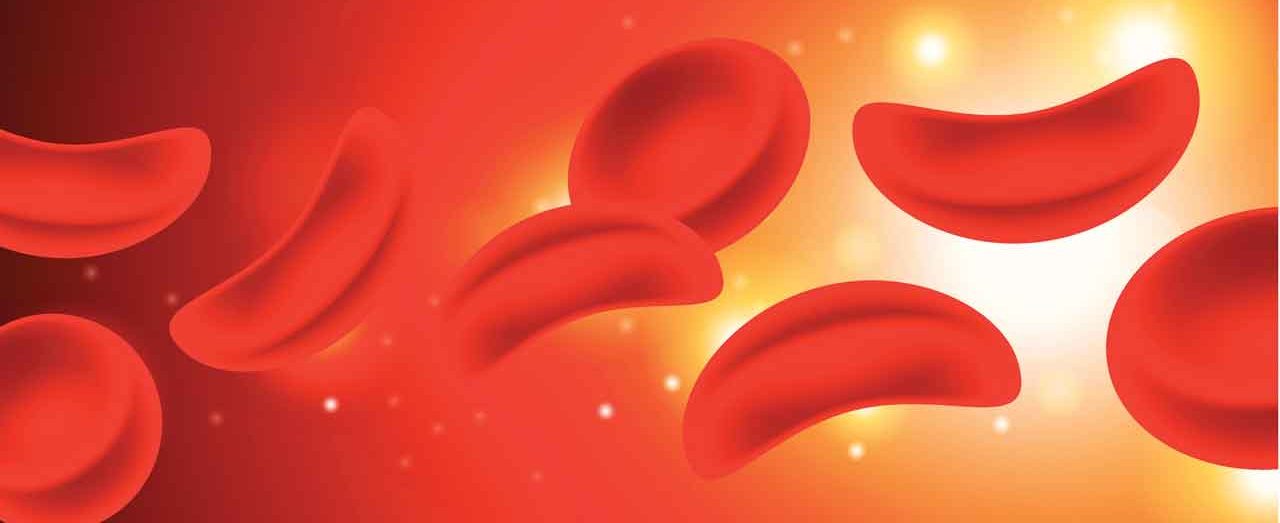What Is Sickle Cell Anemia?

Learn what sickle cell anemia is, how sickle cell anemia symptoms develop — and what it means for you and your family if you carry the sickle cell trait.
Sickle cell anemia, often called sickle cell disease (SCD), refers to a group of inherited red blood cell disorders. All forms of sickle cell anemia disease are similar, although severity of symptoms can vary.
Healthy red blood cells, which are made inside bone marrow, are round and move easily through small blood vessels, carrying oxygen throughout your body. They also remove carbon dioxide, transporting it to your lungs, where it is exhaled.
In sickle cell anemia, red blood cells are hard, sticky, and C-shaped, like a sickle. Unlike normal red blood cells, which die after about 120 days, sickle cells die far more quickly. The result is anemia — a constant lower-than-normal number of red blood cells.
Because sickle-shaped red blood cells aren’t good carriers of oxygen, they can cause damage to your brain, spleen, eyes, lungs, liver, and multiple other organs and organ systems. When they block blood vessels, the sticky, hard sickle cells sometimes cause strokes, according to the Centers of Disease Control and Prevention (CDC).
YOU MIGHT ALSO LIKE: How to Stop an Anxiety Attack
Risk factors and types of sickle cell disease
Sickle cell disease affects millions of people all over the world. The CDC estimates it affects about 100,000 people in the U.S. Sickle cell anemia is most common among people whose ancestors came from:
- Sub-Saharan Africa
- South America, the Caribbean, and Central America
- Saudi Arabia
- India
- Turkey, Greece, and Italy
The type of sickle cell disease commonly known as sickle cell anemia is usually the most severe form of sickle cell disease, according to the National Heart, Blood and Lung Institute. It results when a child receives two sickle cell genes, one from the mother and one from the father.
Less common forms of sickle cell anemia include:
- HbSC. People who have this usually milder form of SCD inherit a sickle cell gene (“S”) from one parent and an abnormal hemoglobin gene, designated “C,” from the other parent.
- HbS beta thalassemia. This type of SCD results from inheriting one sickle cell gene from one parent and one gene for a kind of anemia called beta thalassemia from the other parent. Depending on other genetic factors, this form of sickle cell disease can be mild or severe.
A person can also have sickle cell trait (SCT) and not be sick at all. SCT means a person has inherited the sickle cell anemia gene from only one parent. People with SCT usually have no symptoms of sickle cell disease and live a normal life. If they have children with a partner who has SCT, however, their children may have sickle cell anemia.
Sickle cell anemia symptoms
If a person has sickle cell disease, it is present at birth bur rarely causes symptoms before the baby is about 5 or 6 months old, according to the NHLBI.
Sickle cell anemia symptoms can be mild or severe enough to require frequent hospitalizations, according to the American Society of Hematology.
Sickle cell anemia symptoms include:
- Anemia caused paleness, fatigue, shortness of breath and dizziness
- Dark urine and frequent urination (including bedwetting) due to effects of red blood cell sickling on kidneys
- Painful swelling of hands and feet known as dactylitis
- Yellowing of the whites of the eyes caused by large numbers of sickle cells dying quickly (jaundice)
- Frequent episodes of sharp, stabbing, or throbbing pain almost anywhere in your body, resulting from sickle cells blocking blood flow and oxygen
- Stunted growth in children
Complications of sickle cell anemia can include frequent bacterial infections, injuries to blood vessels in eyes, gallstones, and liver damage. Acute chest syndrome, marked by severe chest pain and difficulty breathing, and stroke — which can occur in children as young as two, as well as adults, when sickle cells block blood flow to part of the brain — are medical emergencies.
What is sickle cell anemia testing?
As recently as 1970, children born with sickle cell disease often died in childhood from overwhelming infection or strokes. But over the past several decades, researchers began figuring out exactly what sickle cell anemia is.
Although there’s no cure for sickle cell anemia, early diagnosis and medical treatments to relieve pain, prevent infections, and minimize organ damage can help people with SCD manage and live with their disease. Advances in recognizing and treating SCD have resulted in prolonging the lives of people with sickle cell anemia until middle age and often beyond.
It’s important for children with sickle cell disease to be diagnosed and treated early because they are at an increased risk for infections and other health problems. Since 2006, newborns are universally screened for SCD in the mainland U.S., as well as Puerto Rico and the U.S. Virgin Islands.
Diagnosis is simple for babies. A blood test from a heel prick is collected on special paper and sent to a lab for analysis. Newborn screening also reveals whether a baby has sickle cell trait.
Sickle cell anemia can also be diagnosed before a baby is born with a sample of amniotic fluid, or tissue taken from the placenta, the organ that attaches the umbilical cord to the mother’s womb.
Anyone who has not been screened for sickle cell anemia (including children born in countries where newborns are not tested for SCD) can get a blood test at most hospitals, local health departments, and medical centers.
If you have sickle cell anemia, the CDC advises talking to a genetic counselor to discuss what being a carrier means and to learn all you can about sickle cell anemia before deciding to have children.
Updated:
September 27, 2023
Reviewed By:
Janet O’Dell, RN